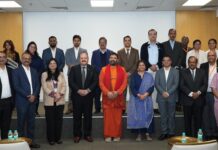The first digital session of the Medical Device Innovation Summit held on 29 August 2020 concluded on a positive note with industry leaders addressing burning topics to promote innovation in the medical equipment industry. The webinar organized by Messe Frankfurt India covered challenges like lack of regulatory systems to its newfound potential to manufacture indigenous products on a large scale. The summit also addressed discussions on new growth opportunities for the overall development of the sector.
Receiving good response from the industry on the current webinar, Messe Frankfurt India planned to launch Medical Device Innovation Summit in a large-format Conference and Exhibition in 2021.
The current pandemic situation has converged the entire medical industry and academia in a never seen before momentum. It has led to the mass production of innovative medical products and awareness of diagnosis and diagnostic tests that will help improve the quality of health in the future. From conducting 1,000 tests per day to 9 lakh tests per day to detect symptoms of Covid-19, India has showcased immense potential to become the global producer and supplier for quality indigenous medical equipment and technologies.
The expert panelist of the webinar included Vijay Kumar of Roche Diagnostics India, Veena Kohli of ADMI – Association of Diagnostics Manufacturers of India (ADMI), Uma Nambiar of Gimcare Hospital, Vijay Simha of Health Start-up Committee (FICCI ), and Jitendar Sharma of Andhra Pradesh MedTech Zone Limited (AMTZ). The session was moderated by Rajiv Nath of the Association of Indian Medical Device Industry (AIMED).
Digital transformation in the medical industry
The current situation has transformed the Indian medical system where everyone is latching on to the digital evolution and healthcare facilities. Homecare, telecare, and tele-medicines are a few expansions that hospitals will provide in increasing numbers in the future.
Sharma emphasized the need for innovation in the therapeutic or treatment segment. He said, “We are fairly good and independent in the diagnostic segment. But on the therapeutic side, robotic surgery, gama knife and linear accelerator are the only kind of major new products currently available on a global level in last five to eight years. This is where Indian entrepreneurship and science can come into picture. To do so, we need a Phased Manufacturing Program (PMP) with calibrated customs duty structure. We must also invest in shareable infrastructure that is technology oriented such as done at AMTZ for benefit of medical device industry.”
Outlook on non-COVID (IVD) test industry for 2020
The in-vitro diagnostics (IVD) is recorded to mark a year on year growth of 30% in 2020, which will be double the market rate in average ten years.
Explaining the statistic, Kohli said, “The Indian In-Vitro Diagnostics (IVD) industry is expected to record a year on year growth of 30% in the year 2020. This will be double the rate at which the industry has been growing in the past decade. The size of IVD industry in the year 2019 was Rs 7500 crore which was slated to grow at a CAGR of about 15% before the COVID crisis. COVID related products have already added Rs 3400 crore to the market size during the first half of the year and by the end of the year, this figure is expected to touch an estimated amount of Rs 7300 crore. Even if the size of non-Covid routine diagnostics products plummet to one third its original value, a base value of Rs 2500 crore will still remain, taking the total industry size to a value of Rs 9800 crore.”
According to her, the IVD industry’s de-growth may sound alarming, but the sharp surge in the Covid test and massive production of indigenous products will make up for the loss this year.
Other important topics discussed during the session included the future of healthcare in India, impact on supply chains, manufacturers, and hospitals during the lockdown, need for a regulatory system for the medical equipment industry, and choosing quality over price competency to ensure ethical products and technologies in the medical field.









